

Project Brief Introduction:
1.Product:Dried Wood Log Pellet Line
2.Capacity:3-3.5 T/Hour
3.TONY Brand 3-3.5 Ton /Hour Dried Wood Log Pellet Line Project Process
4.Main Machine: Wood Chipper , Hammer Mill, TONY Pellet Machine TYJ860-Ⅲ-220KW, Pellet Cooler, Packing Machine And Belt Conveyors
5.Total Power: About 440 kw
6.Need Area: 448About ㎡ L: 28M W:16 M H:6.517 M
Project Layout For Customer:

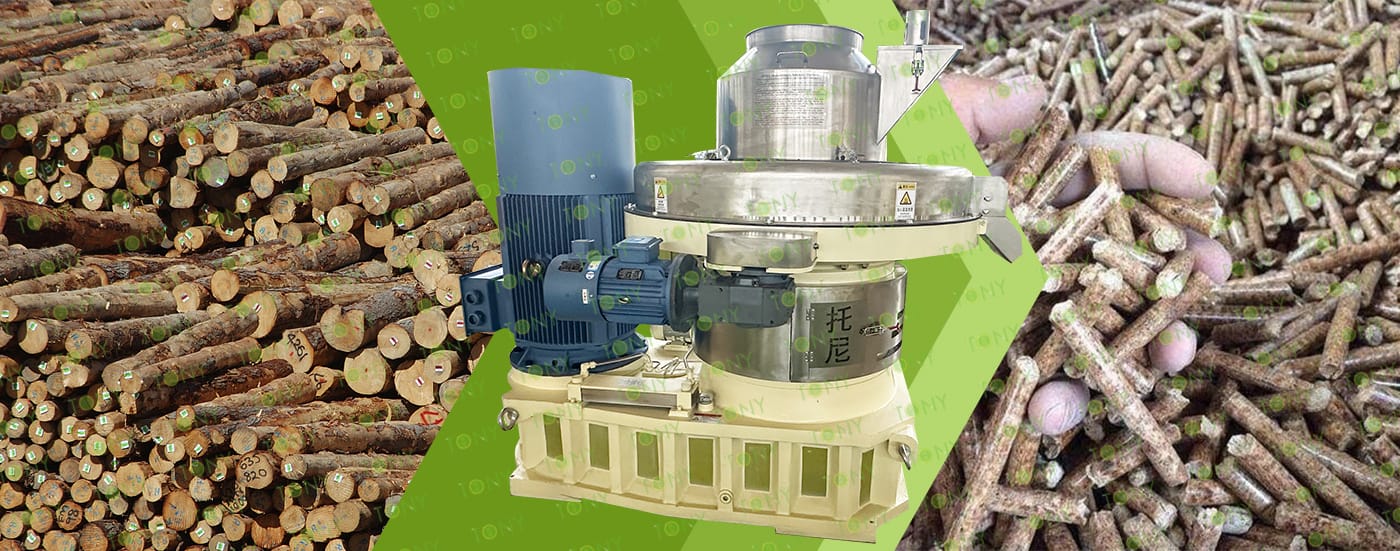
1. The working principle of dried wood log biomass pellet processing equipment
Dry wood biomass pellet processing equipment operates by converting dry wood waste (such as sawdust, shavings, and wood chips) into high-density, regularly shaped biomass pellet fuel through a series of physical processes. This process relies on mechanical extrusion and the natural bonding of lignin, eliminating the need for additional adhesives. The dry wood biomass pellet processing process can be summarized as follows: raw material pretreatment → extrusion molding → post-processing. Because the raw material is "dry wood" (with a moisture content typically controlled at 10%-15%), deep drying is not required. Instead, the process focuses on densifying the material through mechanical force and utilizing the heat generated during processing to activate the bonding properties of lignin, ultimately forming stable pellets.
2. Characteristics of dried wood log biomass pellet processing equipment
Dry wood pellet equipment has clear advantages in energy saving and production efficiency:
(1) Low unit energy consumption: It eliminates the deep drying step (drying energy consumption accounts for 40%-60% of the total energy consumption of biomass pellet processing), and the overall energy consumption is 30%-50% lower than that of equipment that processes wet materials; at the same time, the friction heat generated by dry materials during molding is more concentrated, which can reduce the need for external heating and further save energy.
(2) Strong production continuity: Dry materials are not easy to stick to the inner wall of the equipment (such as the feed pipe and ring die cavity), reducing the downtime and cleaning time caused by material blockage. The continuous operation time of a single pelletizer (1-5 tons per hour) can reach 8-12 hours, which is suitable for large-scale production.
Automation and safety design Modern dry wood pellet equipment generally has a high level of automation and safety assurance:
(1) Intelligent control system: equipped with a PLC control system, which can monitor parameters such as raw material moisture content, feed rate, ring die temperature, and particle density in real time, and automatically adjust the feed speed, roller pressure, etc. to ensure the stability of the finished particle density (1.1-1.3g/cm³) and hardness (crushing strength ≥90%).
(2) Multiple safety protection: equipped with overload protection (automatic shutdown when the equipment is stuck), temperature warning (starting the cooling device when the ring die temperature is too high), metal detection (automatic discharge when metal impurities are detected in the screening process) and other functions to avoid equipment damage or production accidents.
Environmental protection and finished product quality assurance The equipment design takes into account the environmental protection of the production process and the performance of the finished product:
(1) Low pollution emissions: The crushing and screening stages are equipped with dust removal devices (such as pulse bag dust collectors) to reduce the spread of sawdust dust; the pelletizing process does not generate waste gas or wastewater, which meets environmental protection standards.
(2) Finished product is compatible with combustion equipment: The pellets produced are of uniform size (6-8mm in diameter, 10-30mm in length), do not contain additives, have stable combustion power, and low ash content (≤3%). They can be directly adapted to combustion equipment such as biomass boilers and fireplaces, and are easy to store and transport (high bulk density and not easy to absorb moisture).
3. Application scenarios of dried wood log biomass pellet processing equipment
The core application scenario for wood pellet processing equipment is converting wood waste into environmentally friendly fuel.
Raw material sources: Sawdust and scraps from lumber processing plants, branches and trunks pruned from forestry farms, wood chips and shavings from furniture factories, and waste wood from building demolition.
Product Applications:
Residential Heating: Produces clean pellet fuel for fireplaces and home heating stoves, replacing coal and natural gas and reducing pollutant emissions.
Industrial Heating: Provides boiler fuel for food processing plants, building materials factories (such as tile drying), textile mills, and other facilities, meeting steam and hot water needs for industrial production.
Power Generation: Used as fuel in biomass power plants, generating electricity that is fed into the grid through combustion, or provides electricity and heat to distributed energy stations (such as villages, towns, and industrial parks).

TONY Brand 3-3.5 Ton/Hour Dried Wood Log Pellet Manufacturing Plant can take dried wood, various types of wood - related biomass materials, such as branches, small - diameter logs, and wood shavings, with dried wood as the main raw material. After pretreatment and processing, it is solidified into high - density wood pellet fuel. This fuel is an ideal substitute for coal and oil and plays a role in energy conservation and emission reduction. At present, it has been widely used in regions rich in wood resources.
1. Capacity: 3-3.5 Ton/Hour
2. Raw materials: Dried wood logs , branches, small - diameter logs, twigs, etc.
3. Moisture: Dried type, about 10-15%.
4. Application: All kinds of wood - based biomass materials suitable for pellet production.
Suitable customers: Green energy companies, forestry enterprises, and private wood - processing workshops that have advantages in wood raw materials.
5. Finished Pellets Markets: Large power plants ,domestic heating, industrial heating, combustion heat, heating systems, boiler rooms, school canteens, foundry heat sources.

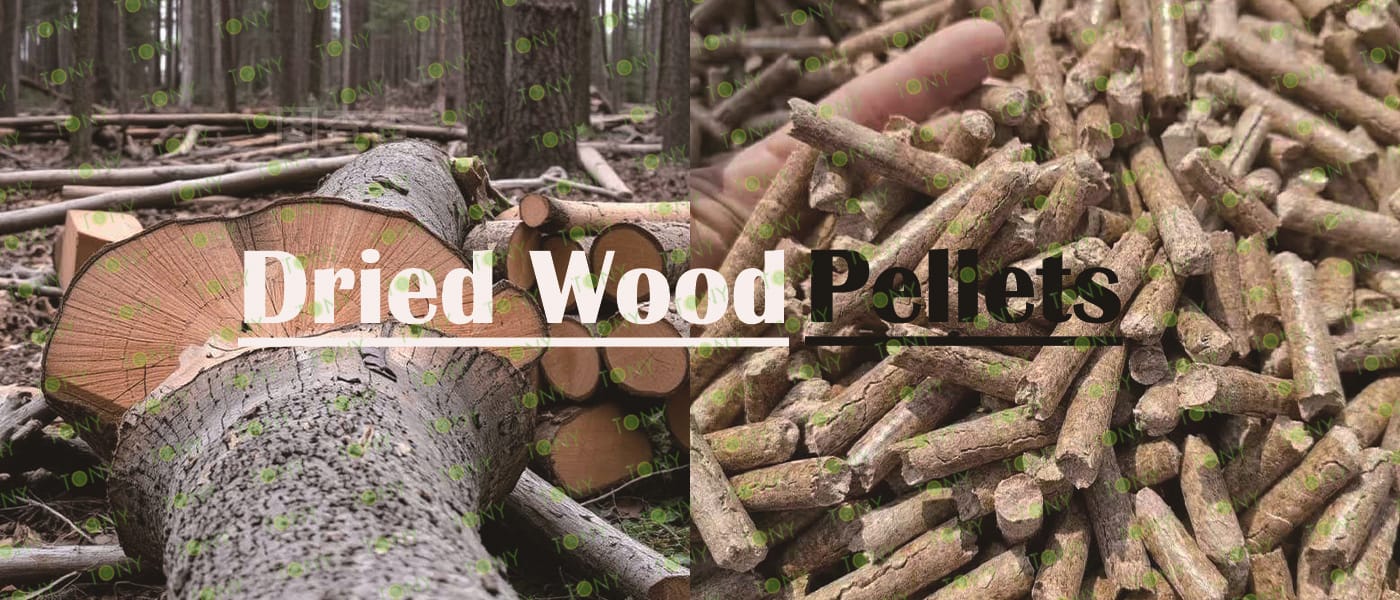
1. Project Name: Dried Wood Log Pellet Production Line
2. Raw Material: All kinds of Dried wood log
3. Moisture Content of Raw Material: 10-15%
4. Capacity: 3-3.5 tons per hour
5. Process: Crushing Process - Fine Crushing Process - Pelletizing Process - Cooling Process - Packing Process
6. Main Equipment: Wood Chipper TPQ216 - 55KW, Effective Hammer Mill-TFD75*100-110kw, TONY Pellet Machine TYJ860 - Ⅲ - 220kw, Pellet Cooler, Small Packing Machine and Belt Conveyors

|
How to use the TONY pellet production line to make pellets from dried wood log? The process mainly includes the following steps and equipment: 1. Use TONY wood chipper to cut dried wood log with a diameter of less than 20 cm into wood chips 25 - 55 mm in length. 2. Use TONY effective hammer mill to crush the 25-55 mm wood chips into 8-14 mm sawdust. 3. Use TONY vertical ring die pellet machine to produce pellets with a diameter of 6-8 mm. 4. Use TONY galvanized cooler to cool the pellets from 80-90°C to 20-30°C. 5. Use TONY semi - automatic packing machine to pack the pellets into bags, each weighing 15-50 kg. For more detailed information and quotations, you can contact TONY. TONY can provide all the above - mentioned products at highly competitive prices and with excellent quality. |
|
|||||||||||||||||||||||||||||||||||||||||||||
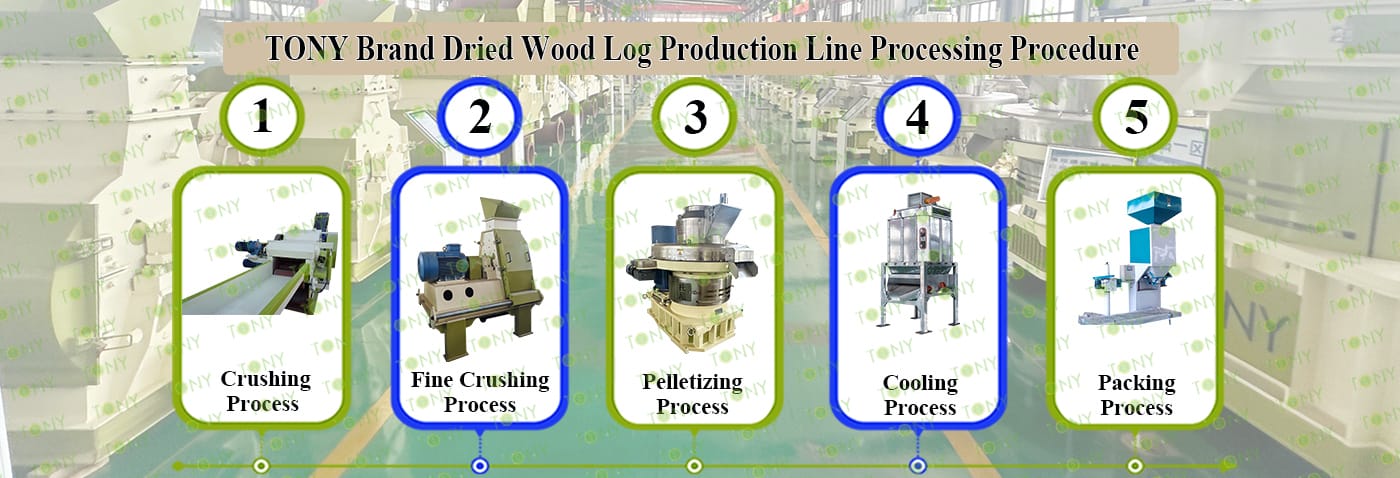
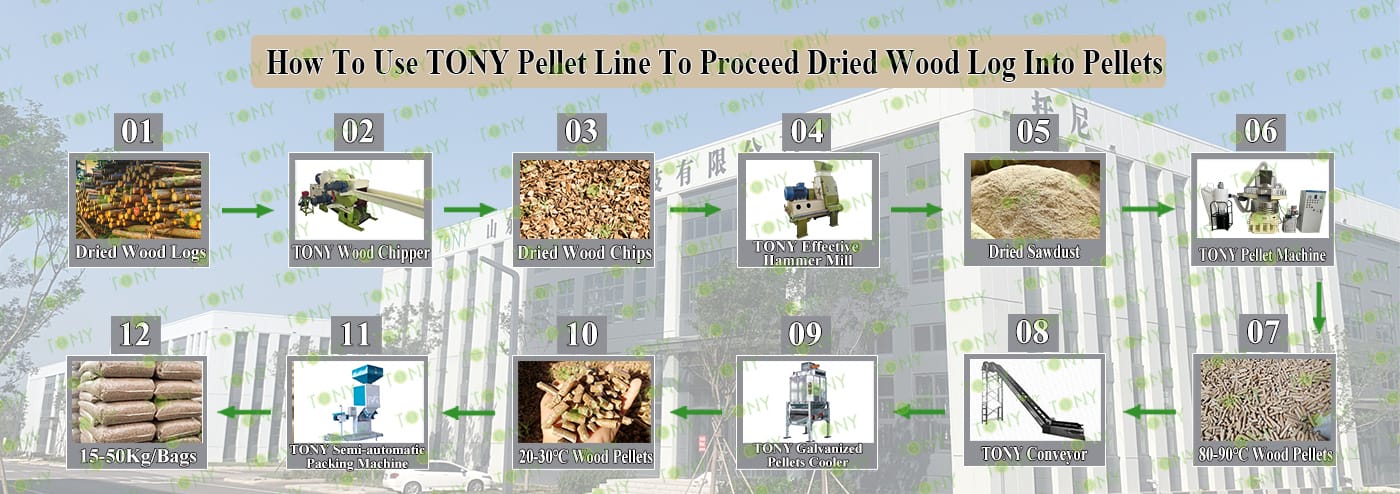

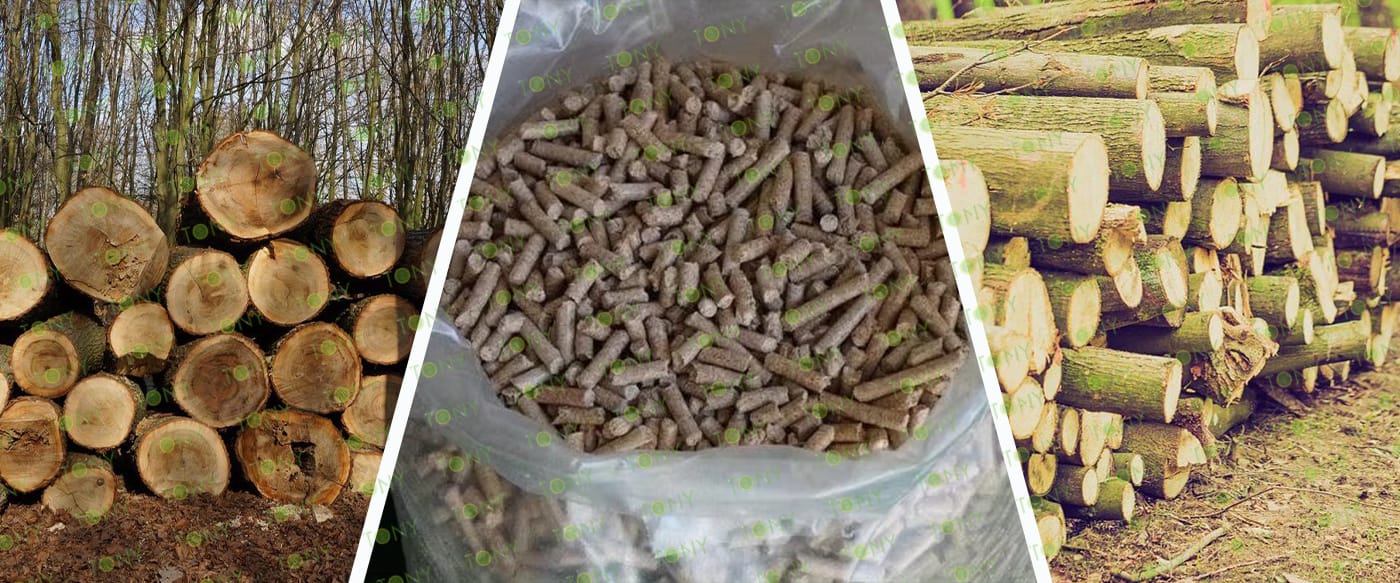


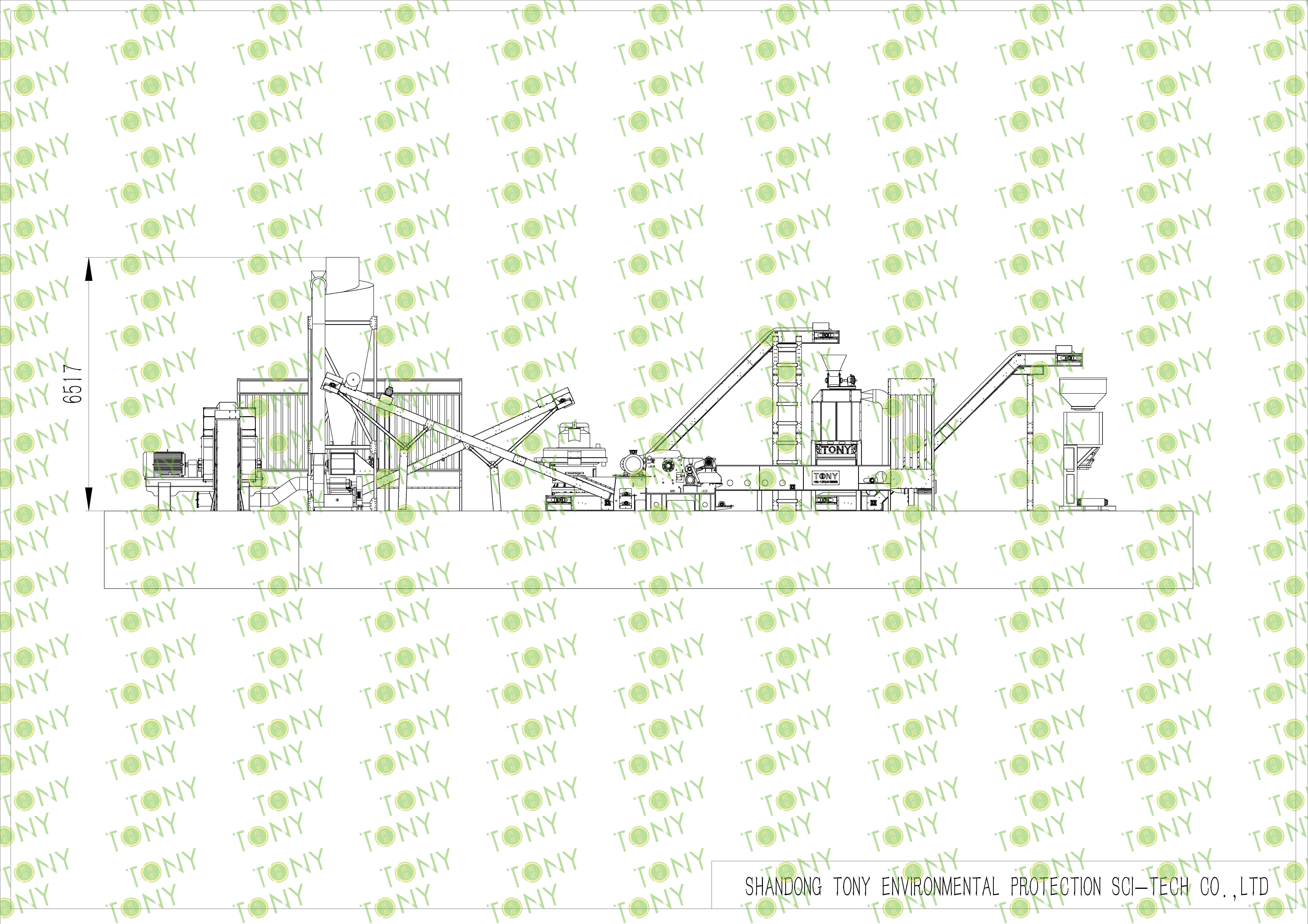
| Next, TONY Will Introduce To You All The Necessary Machinery That Will Be Used For The Whole Pellet Production Line. Some Machines Can Be Custom - Made By Customers According To Different Customers' Detailed Demands. Contact TONY For More Details, Including Quotation And Layout. | ||
 |
 |
 |
| Wood Chipper | Effective Hammer Mill | Vertical Ring Die Sawdust Pellet Machine |
| 1.To Grind Wood Logs φ ≤20cm Into25-55mm Wood Chips. 2.Model: TPQ216-55KW With 2 Baldes*1set 3.Capacity: 4-7Ton/Hour. |
1.To Crush 25-55mm Wood Chips Into 8-14mm Sawdust. 2.Model: TFD75*100-110KW*1set 3.Capacity: 3-3.5 Ton/Hour/Set |
1.To Press Dry Sawdust Into 6-8mm Biomass Pellets 2.Model: TYJ860-III-220KW*1 Set 3.Capacity:3-4Ton/Hour/Set 4.New 304SS Type |
 |
 |
 |
| Galvanized Pellets Cooler | Semi-automatic Packing Machine | Belt Conveyor |
| 1.To Cool Pellets From 80-90℃ Into 20-30℃ 2.Model: TCN-2.5*1set 3.Capacity:3-3.5Ton/Hour |
1.To Pack Pellets Into 15-50KG/Bags. 2.Model: TBF-50*1Set 3.Capacity: 3-3.5Ton/Hour |
1.To Transport Wood Chips,Sawdust,Pellets. 2.Width: 50cm*4sets 3.Capacity:Designed With The Whole Line |


 TPQ216-55KW机器图
TPQ216-55KW机器图
1.Wood Chipping Process:
A.This process is mainly used to grind the wood logs whose diamater is under 20cm into wood chips with size 25-55mm. The finish wood chips size can be adjustable by changing different sizes of screeners and adding flying knives inside the wood chipper.
B.TONY Brand TPQ216 model with 2 flying blades type
C.Capacity:4-7Ton/Hour.
Main Parts:
(1).TONY's Wood Chipper.
(2). Feed And Discharge Belt Frequency Control To Prevent Card Material
(3). Hydraulic System Control Can Be Used For Thicker Materials
(4). Electronic Control System Allows The Equipment To Be Used Normally
Contact Tony For More Details With Quotation

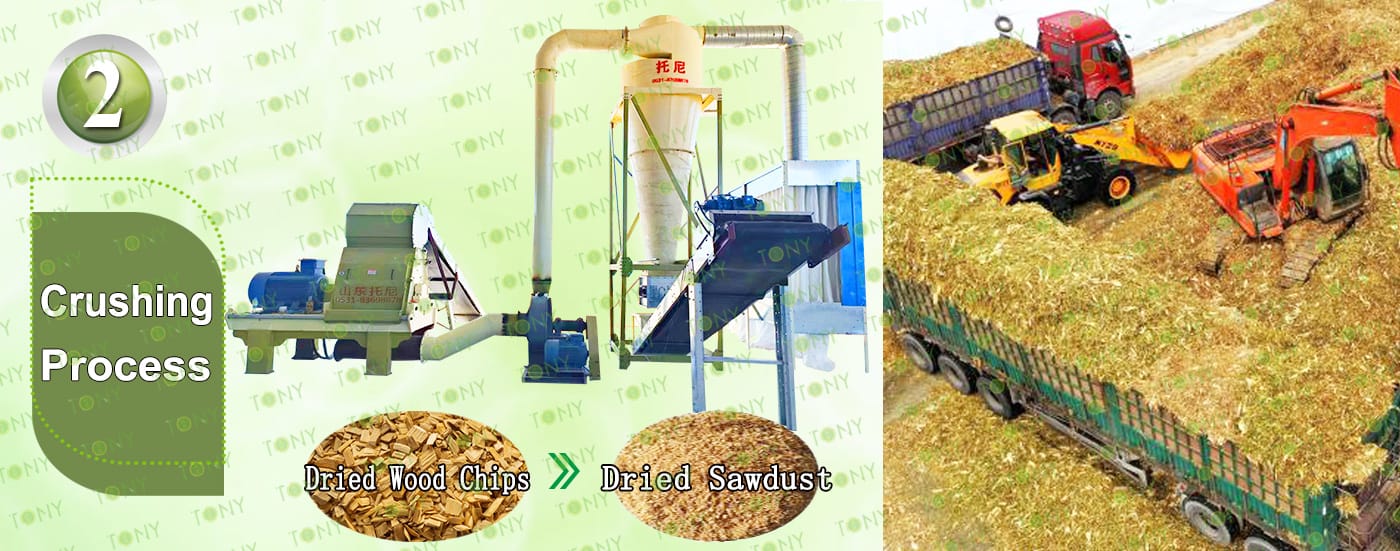
2.Wood Chips Fine Crushing Process:
A.This process is mainly used to crush 25-55mm wood chips into 8-14mm sawdust.
B.Capacity:3-3.5Ton/Hour.
C.TONY use effective hammer mill TFD75*100*110KW*1set
Main Parts:
(1). TONY Effectivel Hammer Mill.
(2). Galvanized Dust Collector.
(3). Sawdust Transportation Fan Blower.
(4). Cyclone With Airlock.
(5). Electrical Cabinets.

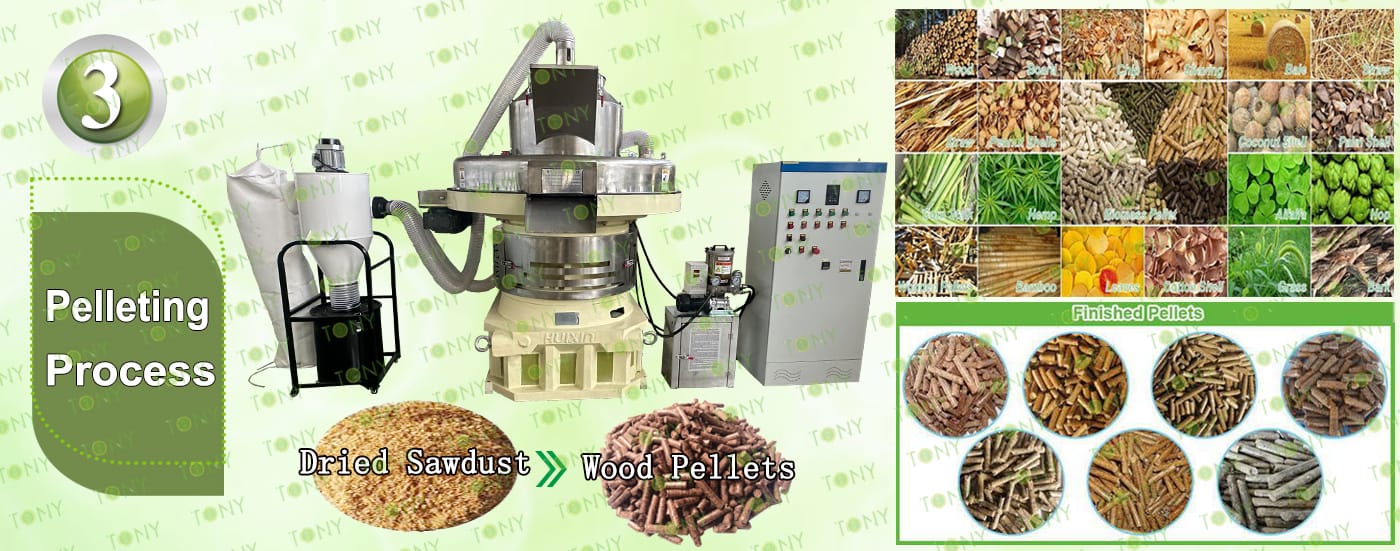
3.Pelletizing Process:
A.This process is mainly used to to product pellets into φ6-8mm.
B.Capacity:3-4Ton/Hour.
C.TONY Brand Vertical Ring Die Pellet Machine TYJ860-III-220KW*1Sets
Main Parts:
(1). TONY's New Vertical Ring Die Pellet Machine.
(2). Cyclone And Bags Dust Collectors.
(3). Automatic Lubrication System.
(4). Electrical Cabinets.
You can chose TONY new type SS304 pellet machine

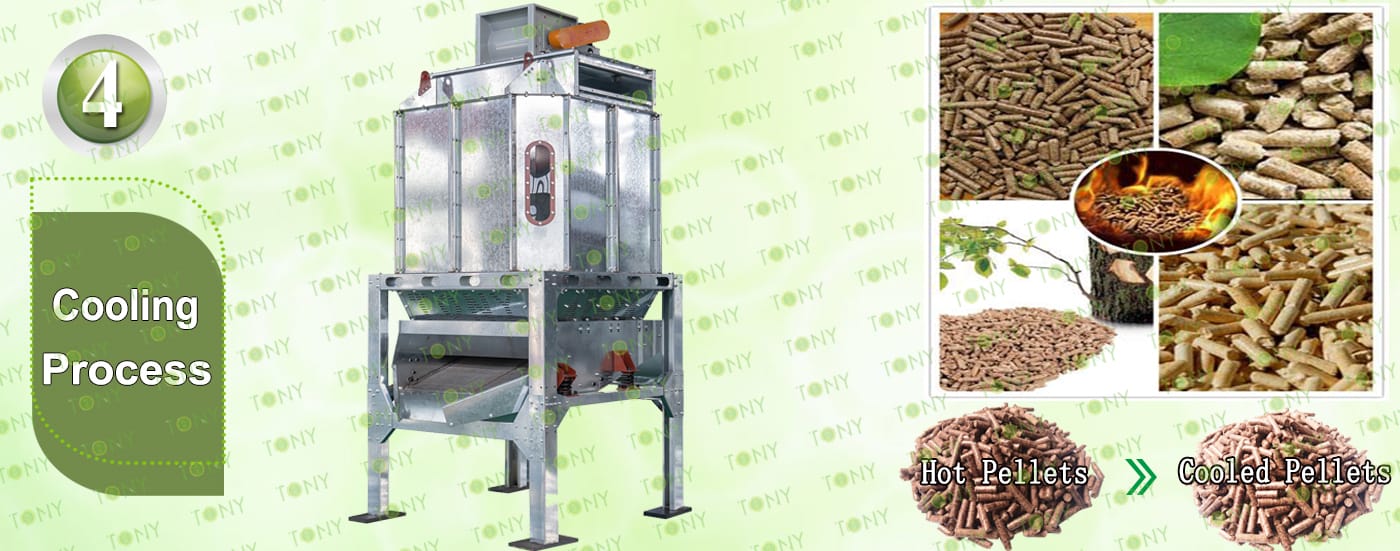
4.Cooling Process:
A.This process is mainly used to cool pellets from 80-90℃ to 20-30℃
B.1Set Of TONY Galvanized Cooler Seperator With Capacity 3-3.5Ton/Hour
Main Parts:
(1).TONY's Galvanized Cooler Seperator With Vibrating Screen.
(2).Cyclone And Bags Dust Collectors.
(3).Fan Blower.
(4).Connect Pipes.

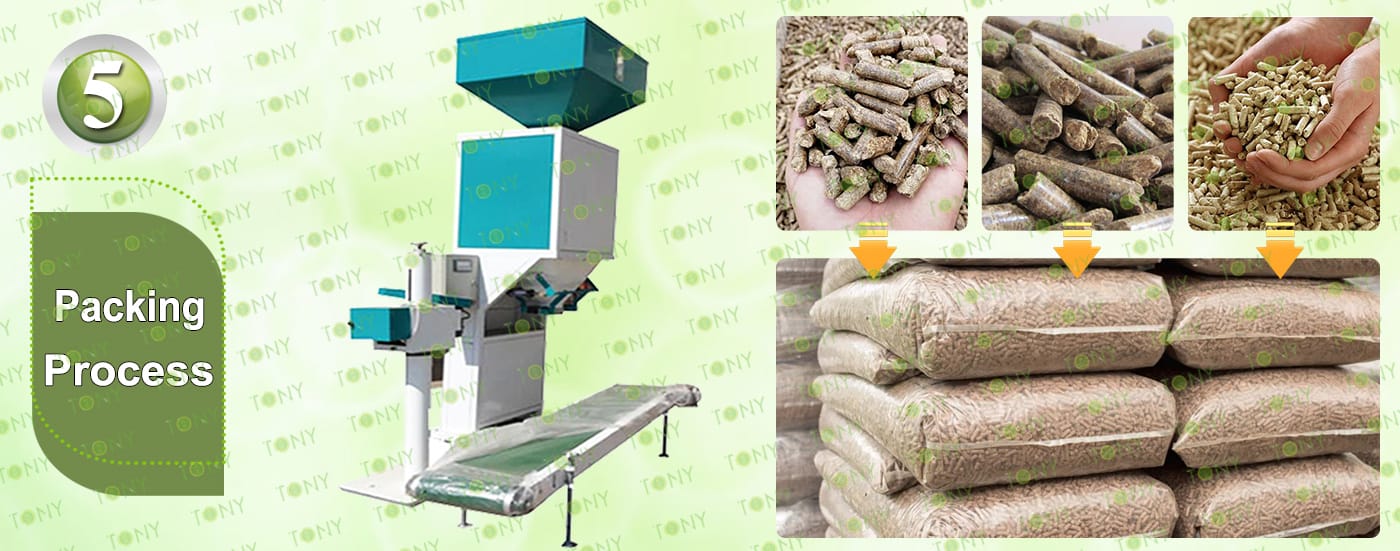
5.Packing Process:
A.This process is mainly used to pack pellets into 15-50KG/Bags.
B.1 Set of TONY Semi-Automatic Packing Machine.
Main Parts:
(1).TONY's Semi-Automatic Packing Machine.
(2).Sew Machine, Buyer Can Also Choose Hot Seal Machine For Chosen,To Confirm With Tony For The Price Difference.
(3).Bags Transportation Conveyors.
(4).Feeding Inlet Silo.
(5).Electrical Cabinets.

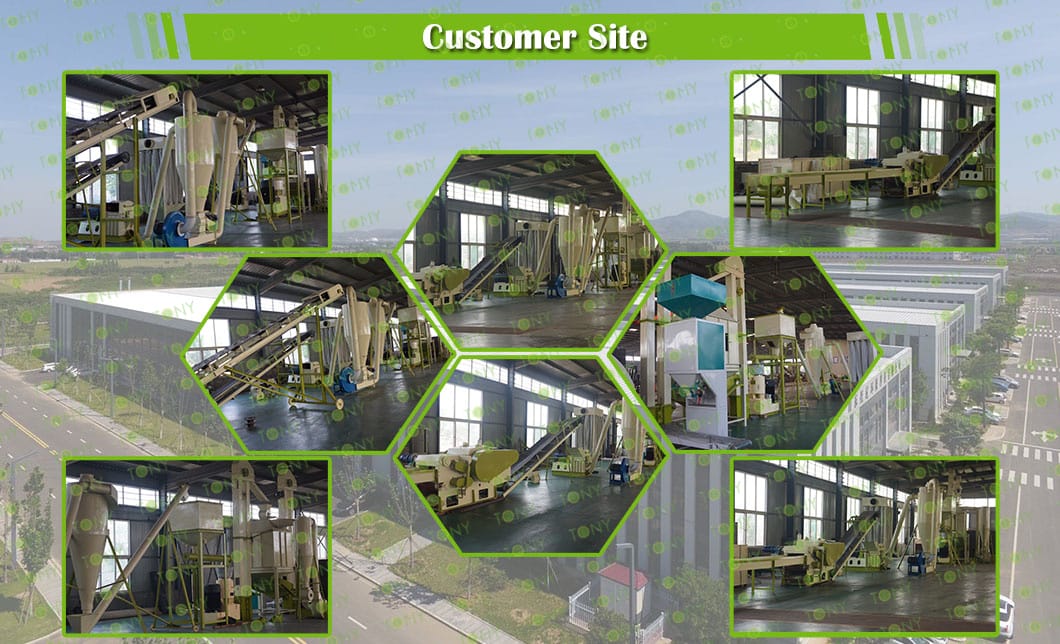

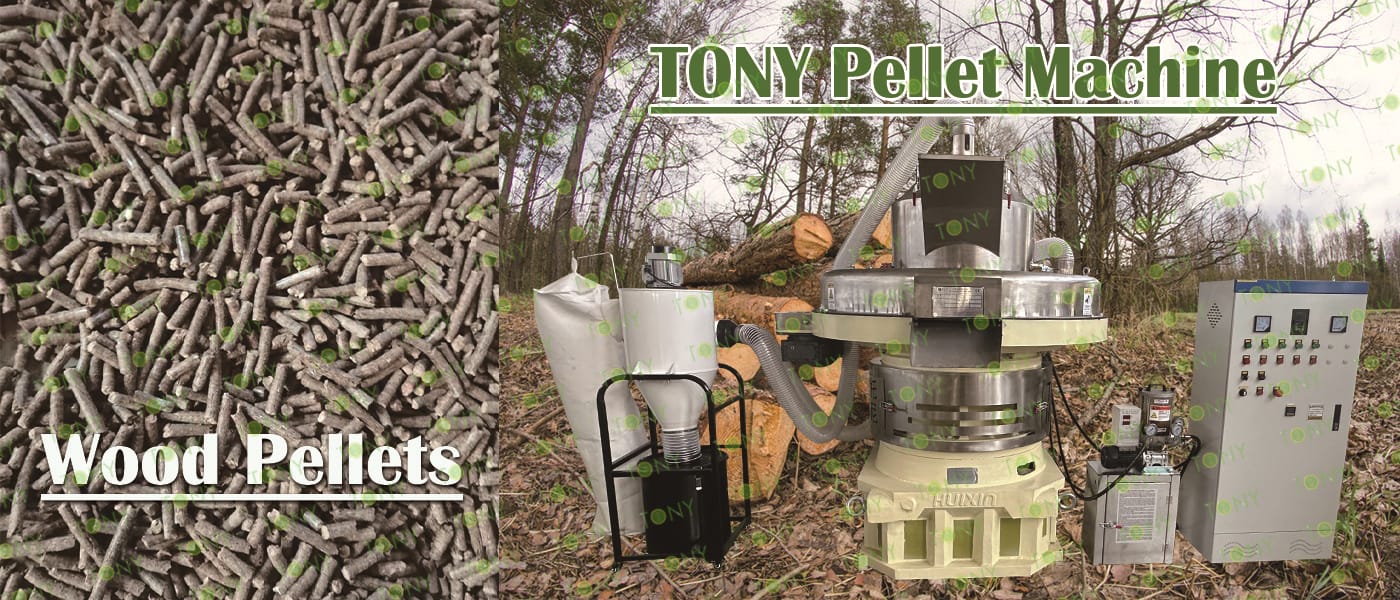
Biomass pellet fuel has a wide range of applications, and the market size continues to grow. Specific demand scenarios include:
Industrial boiler fuel: Many factories require fuel for heating their boilers, and biomass pellets can serve as a clean alternative energy source. Paper mills, food processing plants, and other industries all have related demand, with this sector accounting for over 55% of the market share.
District heating: Clean heating is being promoted continuously, and biomass pellets can be used as a heat source fuel, with a stable annual procurement volume.
Biomass power generation: The demand for pellet fuel is relatively rigid.
Raw Material Pretreatment: Dry wood is crushed in a crusher and then refined into a suitable sawdust particle size by a grinder, providing qualified raw material for subsequent pelletizing.
Pellet Forming: The pretreated sawdust is conveyed to the pelletizer, where it is pressed into biomass pellets under high temperature and high pressure.
Cooling and Screening: The newly produced pellets are hot and require cooling equipment to reduce the temperature. Screening machines are then used to remove substandard pellets, ensuring the quality of the finished product. Packaging and warehousing: Qualified biomass pellets are packaged and then sent to the warehouse for storage and sale.


1. Stable and High Calorific Value:
Dry wood biomass pellets typically have a calorific value of 4200-4800 kcal/kg, close to that of high-quality bituminous coal (4500-5500 kcal/kg) and significantly higher than straw pellets (3000-3800 kcal/kg). They can meet the calorific needs of various applications, including industrial and residential heating.
2. Complete Combustion and High Utilization:
The pellets have a density of 1.1-1.3 g/cm³ and a dense structure, enabling stable, layered combustion in specialized furnaces. They achieve a combustion efficiency exceeding 85% (compared to approximately 60%-70% for coal-fired boilers), reducing energy waste.
3. Easy Control and High Adaptability:
The pellets have a regular shape (6-8mm diameter, 10-30mm length), and the feed rate can be precisely controlled via an automated feeding system. It is compatible with a variety of equipment, including industrial boilers, household fireplaces, and biomass generators, ensuring easy operation.
4. Wide Range of Raw Material Sources:
The raw materials primarily utilize wood processing waste (wood chips, shavings, and scraps) and forestry waste (branch branches and dead wood). These raw materials are abundant and even freely available in furniture factories, sawmills, and forest areas, eliminating the need to occupy arable land and competing with crop production.
5. Low Processing Cost:
The moisture content of dry wood raw material is typically 10%-15% (no additional drying is required, or simple airing is sufficient). Compared to straw (which often has a moisture content exceeding 30%, requiring high drying costs), this method can save 30%-50% in pre-processing costs, reducing overall production costs.






2025 Tony Machinery - All Rights Reserved. Map